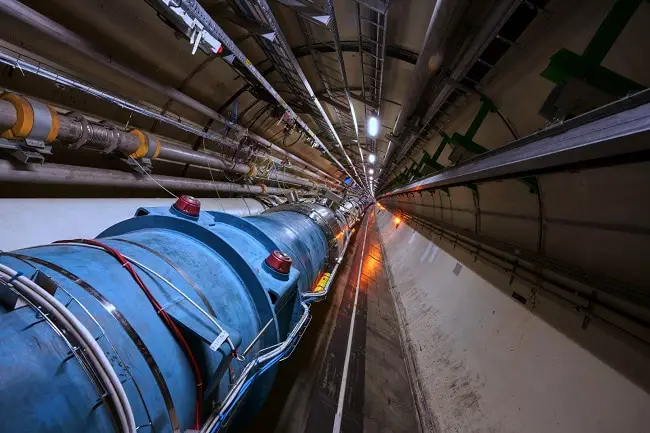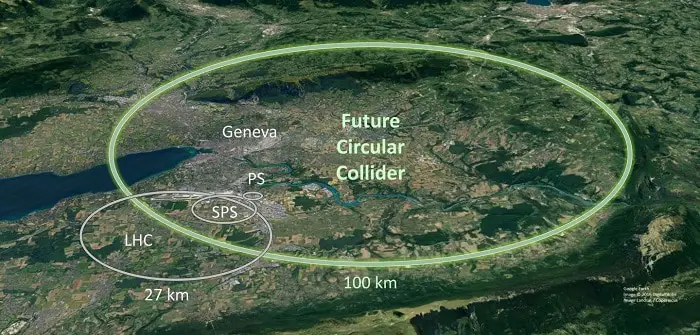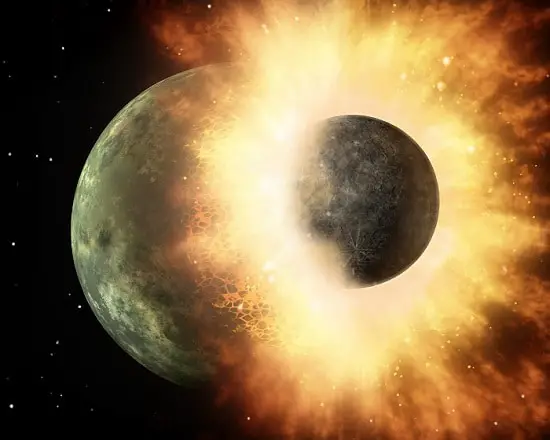Soon after NASA contracted SpaceX to develop, manufacture, and fly two human-crewed lunar missions under the Artemis program, Physicists too are dreaming big to develop a Large Hadron Collider on Moon.
In fact, they had even laid out the plan for the construction of the biggest ever particle collider on the lunar surface. The idea is to construct an 11,000 Kilometers long Lunar Hadron Collider that could give rise to energy 1,000 times greater than the Earth’s Large Hadron Collider.
BUT, WHY???
I mean, if we wanna make a gigantic hardon collider (even bigger than CERN’S Particle Collider), why won’t we make it on Earth…!!! Why on the lunar surface???? Let’s get into what that means and what we need to know about it…!!!
What is a Hadron Collider?

By definition, a (Large) hadron collider is the most powerful particle accelerator as well as the particle collider in the world. The world’s biggest particle accelerator is 27 kilometers long that passes beneath the French-Swiss border near Geneva.
Currently, it holds the world record for producing a proton-proton center of mass collision energy of 13 TeV (Tera Electron Volt) with a dipole magnetic field of 7.7 teslas (T). Not to mention, one of the most celebrated accomplishments of the Large Hadron Collider is that LHC confirmed the existence of the Higgs Boson.
So, how does it work?
See, at first, this majestic device accelerates the particles up to the speed of light. Later, they collide all the accelerated particles with each other. And by doing so, a large number of the detected and undetected particles are produced. That’s it.
What’s the purpose of its existence?
Well, there are so many unsolved questions in physics that have to be answered one day. Therefore, out of desperation, some of the greatest minds think (I would say believe) that with the help of particle accelerators, these unanswered queries can finally be answered, or, at least, has a glimpse of its understanding. For example:
- Is there a relation between Quantum Mechanics and General Relativity?
- Measurement of the mass of the neutrino
- Some more undetected elementary particles
- Nature of SuperSymmetry
- Is there any extra Dimension as per String theory?
- Structure of deep space at the quantum level
- What’s the nature of Dark Matter?
- Are there any more flavors of Quark?
- Grand Unification Theory
- Is the standard model of particle physics correct?
Check Out: Hence, That’s How Was The Moon Formed…!!!
Why Hadron Collider on Moon?
That’s the ultimate question of this hour. Why do physicists think that we should have a hadron collider on the moon? I mean we already have so many of these sophisticated devices on our mother earth? We have 26 kilometers long LHC in Geneva.

Not to mention, there is already a proposed Earth-based Future Circular Collider that is still in its developing stage. As per CERN’s official website, it would be 100 km in circumference with the aim of reaching the proton-proton center of mass collision energy of 100 TeV.
So, why there is a need to build an 11,000 km Circular Hadron Collider on the Lunar Surface? In other words, why can’t we make an enormously large particle accelerator on Earth? Let’s find out…!!!
Issues with Earth
As per our esteemed scientists, the bigger the particle accelerator, the better will be the result. In other words, the greater the collision energy, the greater will be the end result. So, why can’t on earth? Why on the lunar surface?
Well, obviously, there would be some setbacks regarding the installation of an enormously big particle accelerator that could produce collision energy 1,000 times greater than the Large Hadron Collider at CERN with a dipole magnetic field of 20 teslas (T).
First is the Temperature issue
A key requirement for the working of hadron collider is the efficiently cold temperature. And, that can be easily achieved on the lunar surface. In other words, there is no atmosphere, hence, no greenhouse effect.
Disturbing natural habitat
In order to install a particle accelerator that big on earth, a lot of humans, as well as animal habitats, have to be displaced. On the other hand, there is no issue like this on the lunar surface. Obviously, you know why…!!!
Editor’s Choice: Indeed, the moon is moving away from earth, BUT WHY?
To sum up
As per the press release, the Moon is considered the most promising location for artificial particle sources outside the Earth. One of the physicists, Nikolai Zaitsev says that this natural satellite is surrounded with a deep vacuum, is at low cryogenic temperatures, and the moon is always facing the Earth with one side.
Not to mention, there are some issues with the moon such as the power source. I mean just because the moon is tidally locked with the Earth, it doesn’t have enough surface that’s always exposed to the sun.
As a result, installing a solar-powered Circular hadron collider on the moon would be a next to impossible task. That is why even the author of this research paper James Beacham and Frank Zimmermann considered this idea of a gigantic hadron collider on the moon is primarily for fun. In other words, It’s a Pipe Dream…!!!
That’s it for this post. If you like this article, share it if you like, like it if you share it. You can also find us on Mix, Twitter, Pinterest, and Facebook. Hey man, If you have come this far, do give us feedback in the comment section. It would make my day. You can also make a donation. Your donations will help us to run our website and serve you BETTER. Cheers!!!
You might also like:
- Physicists confirm Hawking’s Black Hole Area Theorem; BUT, there is a catch…!!!
- Astronomers Detect Black Hole and Neutron Star merger: First of its Kind
